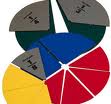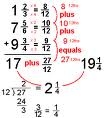Jerome Bruner

Jerome Bruner proposed that the main aim of education is to produce “autonomous, self-propelled learners." To understand how to achieve this goal Bruner studied cognitive growth from the “outside in” as well as the “inside out."
Inside out
Bruner thought that learners interpret the world through three modes of representation: enactive, iconic, and symbolic. He believed that these modes of representation followed in sequence, but unlike developmental theorists such as Piaget, he argued that they are not age dependent. They in fact depend on the learner’s familiarity with the subject matter which of course is highly influenced by the environment. Because of this, Bruner was a true instructional designer at heart and thought that it is not important to ask if a learner is cognitively ready for the subject matter, but if the subject matter is ready for the learner.
The design of instruction, according to Bruner, should follow through these modes of representation. Once learners have acquired a strong symbolic system, the first two stages may be omitted, but learners then run the risk of not obtaining the fundamental understanding of concepts. To gauge a learner’s dominant mode of representation in a particular field, his or her prior knowledge must be assessed.
To save time, teachers will often skip the enactive and iconic stages and teach the the subject exclusively in the symbolic mode. In mathematics for example, we often learn the procedures for solving problems with formulas without knowing what they mean. Given enough time, Bruner would suggest that students study mathematical relationships first with the tactile manipulation of objects, then a visual representation, followed by the numbers and formulas. Let's look at example of these three modes more closely.
Inside out
Bruner thought that learners interpret the world through three modes of representation: enactive, iconic, and symbolic. He believed that these modes of representation followed in sequence, but unlike developmental theorists such as Piaget, he argued that they are not age dependent. They in fact depend on the learner’s familiarity with the subject matter which of course is highly influenced by the environment. Because of this, Bruner was a true instructional designer at heart and thought that it is not important to ask if a learner is cognitively ready for the subject matter, but if the subject matter is ready for the learner.
The design of instruction, according to Bruner, should follow through these modes of representation. Once learners have acquired a strong symbolic system, the first two stages may be omitted, but learners then run the risk of not obtaining the fundamental understanding of concepts. To gauge a learner’s dominant mode of representation in a particular field, his or her prior knowledge must be assessed.
To save time, teachers will often skip the enactive and iconic stages and teach the the subject exclusively in the symbolic mode. In mathematics for example, we often learn the procedures for solving problems with formulas without knowing what they mean. Given enough time, Bruner would suggest that students study mathematical relationships first with the tactile manipulation of objects, then a visual representation, followed by the numbers and formulas. Let's look at example of these three modes more closely.
Enactive Representation

Enactive representation is a kinesthetic learning experience.
For example young learners may use manipulatives in their math classes to understand the concept of fractions. This tactile experience allow learners to see and feel objects to understand basic concepts rather than memorizing the procedures.
For example young learners may use manipulatives in their math classes to understand the concept of fractions. This tactile experience allow learners to see and feel objects to understand basic concepts rather than memorizing the procedures.
Iconic Representation

Iconic representation involves learners experiencing concepts through visual images.
Continuing with an example in math, an example of iconic representation would be when a teacher projects images of pizza or pie charts on a board to demonstrate fractions.
Continuing with an example in math, an example of iconic representation would be when a teacher projects images of pizza or pie charts on a board to demonstrate fractions.
Symbolic Representation

Symbolic representation involves an abstract representation of concepts through a coding system.
For example, once students have understood the concept of fractions by using manipulatives and performing calculations with images of pie charts they may be ready to add and subtract fractions using numeric representations on paper.
For example, once students have understood the concept of fractions by using manipulatives and performing calculations with images of pie charts they may be ready to add and subtract fractions using numeric representations on paper.
Outside in
How should learning be constructed given what we know about the three modes of representation? Education is a social enterprise that involves the interaction within a culture. With this in mind, Bruner suggests: learning by discovery.
Discovery learning emphasizes the learner’s role in obtaining knowledge for him or herself. This can be accomplished through carefully constructed problem solving tasks. This type of learning should be self directed but with sufficient prior knowledge and guided practice in inquiry from a teacher. Problems that show surprising results will spur discovery. One such example given in the Driscoll text is the “anti-gravity” demonstration (2005).
Discovery learning emphasizes the learner’s role in obtaining knowledge for him or herself. This can be accomplished through carefully constructed problem solving tasks. This type of learning should be self directed but with sufficient prior knowledge and guided practice in inquiry from a teacher. Problems that show surprising results will spur discovery. One such example given in the Driscoll text is the “anti-gravity” demonstration (2005).
Discovery Learning Limitations
Not everyone agrees in the effectiveness of discovery learning. It is based on Bruner’s idea of creating “autonomous, self-propelled” learners. However, not all students are ready to learn in this way, especially if the content is unfamiliar. Observations of discovery learning in this group have shown that often the higher level students may excel in this learning environment but the more average students may struggle. This may be amplified if the student has been learning in a traditional transmission method for several years before suddenly being introduced to discovery. Students also need to "learn to learn" in this way. It is time consuming. Now, the question is whether or not the results warrant the effort and resources for discovery course design.
Many of us believe that the nature of the workforce for our new graduates will require the ability to learn, unlearn, relearn continuously. This may make “self-propelled learning” an essential skill in tomorrow’s workforce.
Many of us believe that the nature of the workforce for our new graduates will require the ability to learn, unlearn, relearn continuously. This may make “self-propelled learning” an essential skill in tomorrow’s workforce.
Application to Educational Technology
A major challenge that has always plagued online course designers is how to design course content that honestly meets the enactive mode of representation. Certainly the technology has existed for quite some time to present information in an online context for the iconic and symbolic modes. Until now the kinesthetic type of learning has been reserved for face-to-face learning.
On the doorstep of technological innovation in education is something that may change this: augmented reality. Designers are now capable of creating learning objects that may meet the needs of enactive learners much like the way basic manipulatives are presently used in the classroom.
On the doorstep of technological innovation in education is something that may change this: augmented reality. Designers are now capable of creating learning objects that may meet the needs of enactive learners much like the way basic manipulatives are presently used in the classroom.
Discovery learning may also be a good match for augmented reality (AR) as it can also provide an authentic context in location-based learning through geotagging. In some instances it allows students to interact in the real world to acquire knowledge for problem solving. In this example you will see students moving in the real environment as part of a discovery learning project.
This example of discovery learning is much different than the typical guided inquiry discussions normally given as examples of discovery learning. Depending on your teaching philosophy, the diminished role of the teacher in guiding the discovery learning in the AR example may have negative consequences, or from a constructivist view, positive consequences.
Discussion question
Do you think that emerging technology, like the augmented reality games or textbooks shown in the videos, can be used effectively throughout Bruner’s three modes of representation or in discovery learning?
